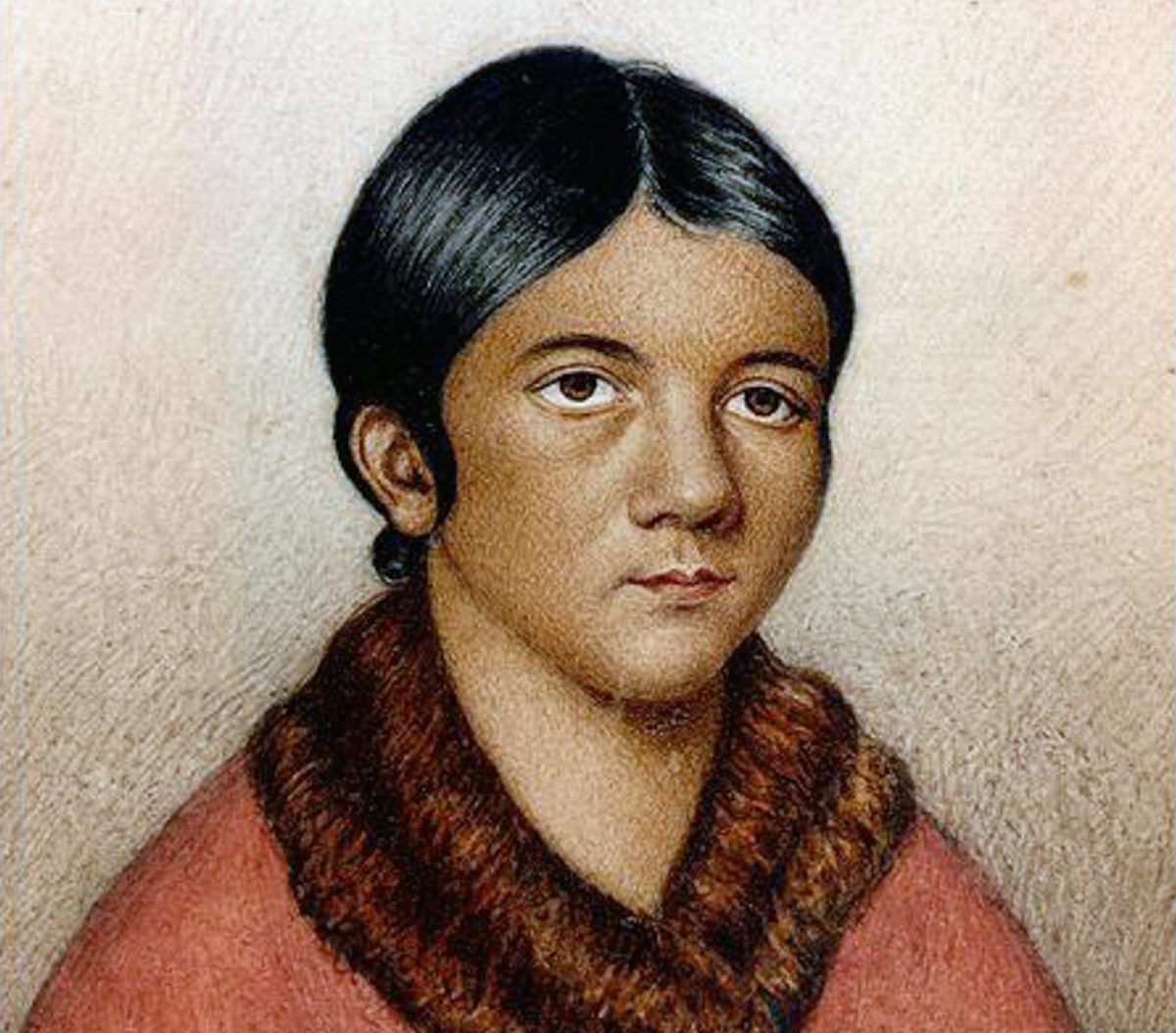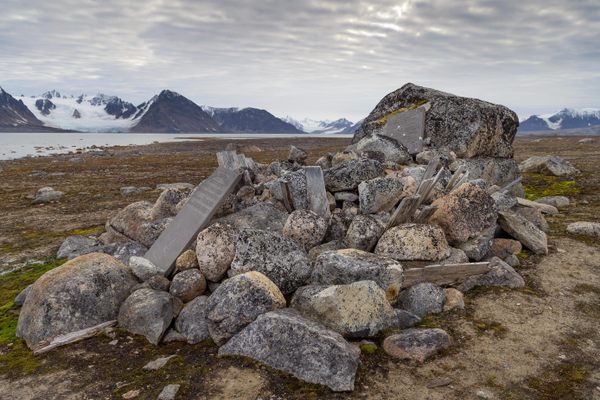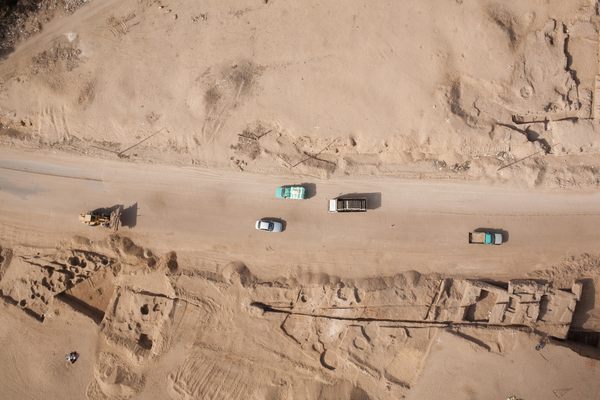In Newfoundland, a Bird Spirit May Have Guided a Lost Culture’s Dead
For centuries, the Beothuk people relied on seabirds to survive—and likely to find their way to the afterlife.

The harsh winds of the North Atlantic roll ceaselessly across rocky islets off the north coast of Newfoundland. These outcroppings of rock, crowned only in mosses and lichens, serve as cemeteries for people of a lost culture. For centuries, the Beothuk people came to these islands in 18-foot birchbark canoes bearing the bodies of friends and family. The dead were placed in graves dug in the meager soil, or under rocky overhangs, wrapped or covered in birchbark. Bark containers, tools, and sometimes model canoes barely the length of an arm were placed beside the dead. Heavy stones were then arranged atop the site to deter scavengers.
Many of the dead wore delicate, beautifully carved pendants smudged with red ochre. These pendants had been whittled and polished down from fragments of caribou bone until they were entirely flat. The Beothuk then carved them into shapes related to birds—the wing-feather of an Arctic tern, for example—and engraved them with geometric patterns. Holes drilled into them allowed the small items to be worn on a necklace or stitched onto clothing, perhaps as a way for the dead to take them on their final journey. Archaeologists do not know their purpose for certain, as much of the millennia-old story of the Beothuk has been lost.
The ancestors of the Beothuk may have arrived on Newfoundland as early as the first century, possibly sharing the island for a brief period with members of the older Dorset culture, which had expanded south from the High Arctic to Newfoundland around 2000 B.C. Evidence of the Dorset culture disappears from Newfoundland about 1,300 years ago, but the people of the Beothuk lineage continued to thrive, their livelihood centered on the island’s rich coastal regions.
Beothuk settlements were located in protected coves and inlets that allowed them to fish and hunt for harbour seals, hooded seals, and walrus. During the great autumn migrations of caribou, hunting parties would move inland and, if the hunt was lucky, bring back plenty of meat for the winter.

But it was the vast colonies of seabirds that existed along Newfoundland’s coastline that allowed the Beothuk to flourish. Their diet included Arctic tern, the now-extinct great auk, geese, and ducks, along with the eggs of these birds, which were gathered and preserved. Eggs were such an important staple of the Beothuk diet that they undertook long and dangerous journeys to nesting sites located miles offshore.
Hunter-gatherer societies often associate animals on which they rely for survival with spiritual power; it is likely that the Beothuk viewed the seabirds both as a practical food source and as powerful spiritual beings.
While the majority of Beothuk burial sites have been looted, a few of them have been professionally excavated by modern archaeologists. Many of the graves that have survived, partially or entirely intact, contain one or more bone pendants. Most depict parts of seabird anatomy—wing feathers and webbed feet, for instance.
The best chance of understanding their significance may be to turn to one of the rare Beothuk oral histories preserved today. In the early 19th century, a Beothuk woman named Shanawdithit shared that her people believed that, after death, their spirits would go on a journey to a happy island far away, “where the sun went down behind the mountains.”

The idea of a journey in the afterlife is common across many cultures ancient and modern. For instance, traditions of the neighboring Mi’kmaq people contain a similar element of the soul journeying after death. Like the Beothuk, Mi’kmaq burials have included model canoes to aid in this passage.
Seabirds are well adapted to travel between different environments, from flying to diving into the sea for food to nesting on land. It is easy to see that the Beothuk might have considered these birds as ideal travel companions in the afterlife. Archaeologists believe this link between soul travel and seabirds most likely explains the bird-shaped bone pendants that were such a significant part of Beothuk burial customs.
How long Beothuk burials continued following this tradition is not clear. By the time looters found and ravaged several graves on the north-central coast in the early 19th century, the Beothuk culture had endured centuries of hostile European contact, including Norse settlers, Basque fishermen, and whalers. As the foreigners exploited the rich coastal resources, surviving Beothuk had retreated inland decades earlier.
In fact, their connection to the sea, and to the seabirds charged with guiding their souls to the afterlife, was severed by the 18th century. By the time the graves were looted along the coast, Europeans claimed that there were only a handful of Beothuk left in the world. Shanawdithit was one of them, and for decades Europeans called her the last of her people—despite Mi’kmaq oral tradition that surviving Beothuk were absorbed into their communities, which has recently been supported by genetic studies. Her family members dead from illness, starvation, or settler violence, Shanawdithit was kidnapped by Europeans. It was then that she told Scottish author and explorer W. E. Cormack of her people’s traditions—and that she feared not being buried with proper Beothuk rites. When tuberculosis claimed her at the age of 28, her fears were realized: She was deprived of the funerary customs of her people, without seabirds to see her home.








































Follow us on Twitter to get the latest on the world's hidden wonders.
Like us on Facebook to get the latest on the world's hidden wonders.
Follow us on Twitter Like us on Facebook